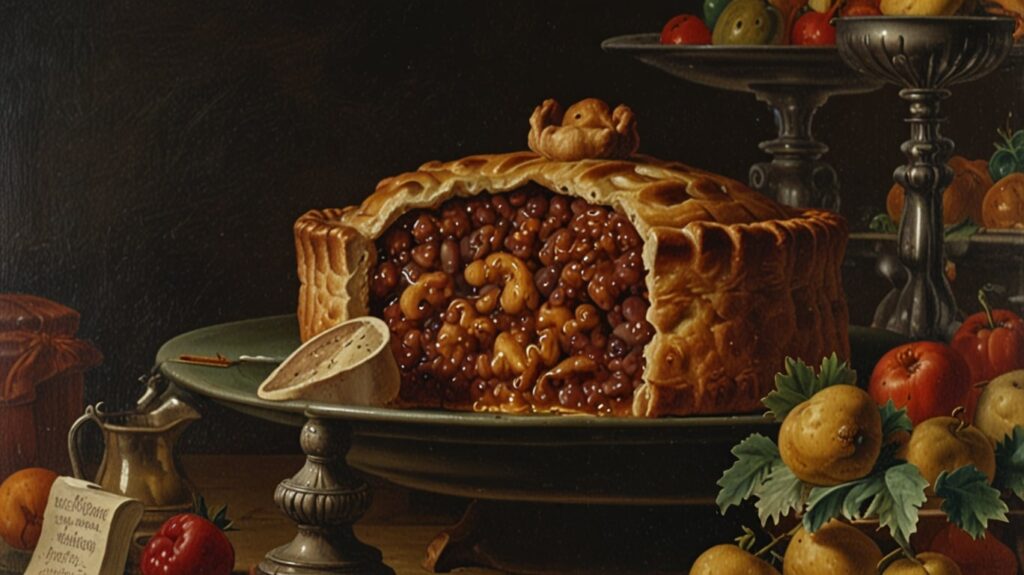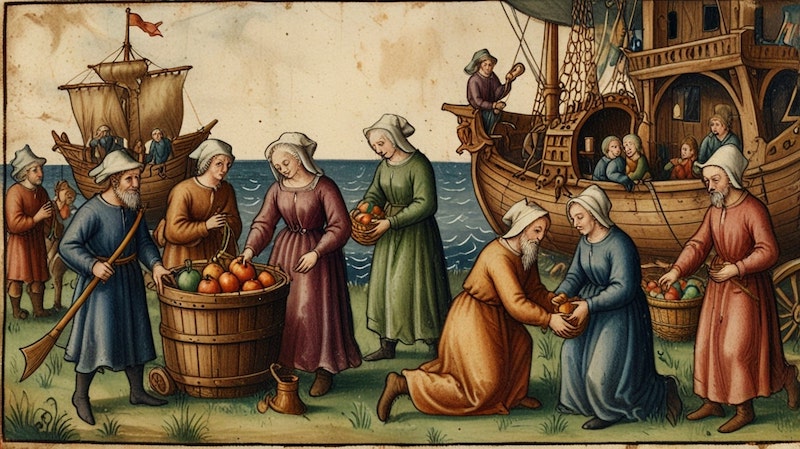The rich History of Pies is fascinating and has evolved from basic dishes to intricate culinary masterpieces. Today, pies are beloved around the world, but their origins and journey through time reveal a deeper, more complex tale.
The Origins of the Word “Pie”
According to food historians, the word “pye,” spelled this way at the time, entered the English language in the 14th century.
The word “pie” may have originated from the idea that nearly anything could be wrapped in dough and cooked to make a pie.
Essentially, if something can be covered in pastry and cooked, it qualifies as a pie.
It may have possibly been derived from the earlier word “magpie” because “the magpie collects a variety of things and puts them in its nest,” just as “people would gather whatever they could afford, whether it be game meat, domestic fowl, or fruits, and place it in a pastry case.”
Early Pies were called Coffins and used as Cooking Vessels
Pies were called “coffins,” spelled “coffyns,” which meant basket or box. They were savory meat pies with tall, straight-sided crusts or dough, with sealed bottoms and lids.To withstand many hours of baking, these crusts were often made several inches thick.
What you need to know about crusts back then is that they were used as cooking vessels. Today, if you wanted to roast some chicken, you would grab a pan and roast it, right?

Back then, if they wanted to roast chicken, they would make pie crusts with very thick walls, place the chicken inside, put the crust over an open fire, and cook away. So, what we would now call a pie shell was used in much the same way we use pots and pans.
When the contents of the pie shell were done cooking, what did they do with the burnt, dry crust?
Wealthy families and nobility were often obliged to feed their servants and the poor. They would frequently give them the crusts that had just been used to cook their game meats.

The word “pie” may have entered the English language in the 14th century, but according to historians, its origins can be traced back to the ancient Egyptians during the New Stone Age period, around 6000 BC.
This was a time when stone tools were first used for domestic grinding. Plants and animals were also domesticated, allowing farmers to cultivate crops, including a variety of wheat that was easy to harvest. Domesticated animals either helped with labor or provided milk and meat—perfect ingredients for an early version of pie.
Early Pies: Galettes in Ancient Egypt
These first pies, or early pies, are known as galettes. They were rustic, free-form pies—often referred to as the “Adam and Eve of pies.” Made with oat, wheat, rye, and barley, they were filled with honey and baked over hot coals.

By around 1237 BC, royal bakers to the pharaohs began adding nuts, honey, and fruits to bread dough, creating a style of pastry. Visual proof of this can be seen etched on the tomb walls of King Ramses II, located in the Valley of the Kings.
Greek Influence on Pie Pastry
The tradition of making galettes was carried on by the Greeks, but they improved upon it. The pies of this period were made using a flour-water paste wrapped around meat, which sealed in the juices while cooking.
According to historians, it is safe to say that the Greeks gave us the first pie pastry by upgrading the rustic free-form pies into pies with a filling. So, thank you to the Greeks for the pie crust pastry!

Roman Elevation of Pie
We all know the Romans conquered Greece, and after sampling those delectable galettes, the spoils of war now included the recipes for making these little delights.
The Romans took experimenting with pie filling to the next level. The wealthiest among them used every type of meat they could find in their pies, even for desserts.
In fact, Roman pies could be filled with all sorts of game meat, oysters, mussels, lampreys, and fish. And yes—you heard that right—the Romans even enjoyed meat or fish pies for dessert!
Animated Pies: A Peculiar Entertainment
As pies became popular, the wealthy and noble classes began to use them as a medium for extravagant entertainment. This led to the creation of Animated Pies, one of the most eccentric forms of amusement at lavish banquets.

Do you remember the nursery rhyme?
“Sing a song of sixpence,
A pocket full of rye.
Four and twenty blackbirds,
Baked in a pie.
When the pie was opened,
The birds began to sing;
Wasn’t that a dainty dish,
To set before the king?”
This rhyme was inspired by actual events. Live birds would sometimes be placed inside large, intricately decorated pies so that when they were cut open, the birds would fly out, delighting and surprising the banquet guests.
From Birds to Frogs and Beyond
Over time, the novelty of birds flying out of pies wore off. As a result, they began to introduce frogs, rabbits, and even turtles into the pies. While frogs leaping out at guests might have been amusing, the thought of turtles slowly emerging must have been less thrilling.
But the desire to outdo each other didn’t stop there. The wealthy moved on from animals to humans. Pies were made large enough to hide dwarfs or little people, who would emerge from the pie to entertain the guests. These performers would stroll along the banquet table, performing magic tricks, reciting poetry, or even drawing or painting portraits of the guests.
Pies as Banquet Spectacles
During the reign of Charles V, King of France, the food at banquets was not the main attraction. Instead, the focus was on minstrels, magicians, jugglers, and dancers. Chefs in the kitchen were considered artists, producing what was known as “soteltie” (spelled “soteltie” or “subtlety” in English).

Originally, sotelties were foods crafted to resemble something else and served between courses. Over time, they became increasingly elaborate and evolved into purely artistic creations, often inedible, designed to entertain guests.
The purpose of a soteltie was to amuse and dazzle guests while they waited for the next course. The chef for the Duke of Burgundy once created a massive pie, which, when cut open, revealed 28 musicians performing from inside the pie.
Extravagant Pie Displays
At the coronation banquet of the eight-year-old King Henry VI in 1429, a partridge pie was served. This dish featured a cooked peacock, re-mounted in its own skin, and placed atop a large pie. Birds like partridges, swans, and herons were frequently used as ornamental decorations on pies, serving as indicators of the type of pie within.
The Dwarf in the Pie: Jeffrey Hudson
Perhaps one of the most bizarre pie-related stunts involved the serving of a dwarf in a pie. While earlier, performers had emerged from pies, this time it was a child—a young dwarf named Jeffrey Hudson.

At a banquet held for King Charles I and Queen Henrietta Maria, a large, crust-covered pie was presented as the centerpiece. As the Queen began to cut the pie, it started to move, and the crust began to rise. To everyone’s astonishment, out emerged seven-year-old Jeffrey Hudson, standing only 18 inches (45 cm) tall, dressed in a suit of armor for the royal couple’s amusement.
English Pie Dominance in the 17th Century
By the 17th century, the English had no rivals, European or otherwise, when it came to baking pies. From humble dishes like cottage pie and shepherd’s pie, made with beef or lamb and topped with potatoes, to extravagant creations fit for royalty, pies were a staple across England.
How Pies came to America.
In 1620, when the Pilgrims boarded the Mayflower for America, they brought their cherished family pie recipes with them. However, upon arriving in the New World, they found that some ingredients were either scarce or unavailable, forcing them to adapt their recipes. They began baking with local fruits and berries, thanks to guidance from Native Americans, who helped them identify which plants were safe to eat.

With fewer resources, they used shallow pans instead of the deeper ones from England, creating shallow pies that used fewer ingredients. By the 18th century, pies had become a part of daily meals, and as settlers moved westward, they spread their love for pies, adapting them to regional ingredients.
Pies in American Culture
By this point, pies were becoming ingrained in American culture. Historical figures like George Washington favored sweet pies, including a unique pie made with sweetbreads and oysters.
Mark Twain was another pie enthusiast; his housekeeper often baked huckleberry pie to tempt him into eating lunch. During his 1878 trip to Europe, Twain expressed his disdain for European food and eagerly anticipated returning to the U.S. to enjoy pies like apple, peach, mince, pumpkin, and squash pie.
Pies weren’t just made at home—they had become popular in restaurants and diners. One notable fan of restaurant pies was James Brady, a well-known glutton and socialite. Brady was infamous for sharing stories of an extravagant supper planned by an architect friend, where a dancer emerged from a massive pie and entertained him. Brady’s reputation for pie consumption was legendary—he often ate entire pies after meals instead of just slices.
How Pies came to Australia
Much like in America, pies arrived in Australia with settlers from England. In 1788, the First Fleet, carrying over 1,400 people, set sail from Portsmouth to Australia. Among the settlers were military and political representatives, workers, and cooks, who brought with them the tradition of pie-making.
One of the earliest recorded references to pies in Australia comes from George Worgan, a First Fleet surgeon. He recounts a convict trying to make a pie for his wedding using parts of a goat, emphasizing the early popularity of pies even among the lower classes. Pies became a fixture of celebratory feasts, such as the one hosted by Governor Phillip for the King’s birthday in 1788.
By the 1840s, pies had achieved celebrity status in Australia, with figures like “The Flying Pie-Man” selling pies at the wharves in Sydney. Over time, savory pies became a cultural icon in Australia, where they remain popular today.
Eccentric Pie Traditions Among the Nobility
The nobility’s love affair with pies took bizarre forms. Emperor William I of Germany, for example, enjoyed a pie that contained a whole turkey stuffed with a chicken, which was stuffed with a pheasant, and then stuffed with a woodcock.
This extravagant dish exemplifies the aristocracy’s penchant for indulgent and eccentric pies, a tradition that spanned across Europe.
From the basic galettes of ancient Egypt to the elaborate animated pies of medieval Europe and the classic apple pies of America, pies have been a staple across various cultures for centuries. Whether filled with savory or sweet ingredients, pies have remained a versatile and enduring part of global cuisine.

